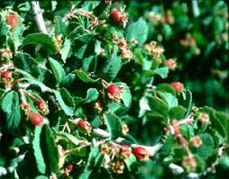 The Utah serviceberry, amelanchier utahensis, is a xeric native deciduous shrub, a spreading plant which grows in the form of both a shrub or small tree to 16 feet in height. The serviceberry grows in varied habitats, from scrubby open slopes to woodlands and forests, and in drier areas on rimrock valleys, gullies and hillsides from sagebrush desert to middle elevations in mountains. It flowers from April to May and offers an edible fruit, summer ripening purple-black berries. It has brilliant yellow fall foliage.
The Utah serviceberry, amelanchier utahensis, is a xeric native deciduous shrub, a spreading plant which grows in the form of both a shrub or small tree to 16 feet in height. The serviceberry grows in varied habitats, from scrubby open slopes to woodlands and forests, and in drier areas on rimrock valleys, gullies and hillsides from sagebrush desert to middle elevations in mountains. It flowers from April to May and offers an edible fruit, summer ripening purple-black berries. It has brilliant yellow fall foliage.
Its flowers cluster on short racemes; the leaves are elliptical to oval, toothed above the middle in general so that the toothed grooves are visible only toward the top of the leaf. The Utah serviceberry blooms in short inflorescences of white flowers, each with five widely spaced narrow petals. The fruits are pomes.
It is browsed by desert bighorns, elk, and mule deer, as well as many birds and domesticated livestock.
This drought resistant/drought tolerant plant produces a sturdy, heavy and hard wood, though the trees are rarely large enough for commercial use. The hardness of the wood makes it suitable for use as the spindle of a fire drill and basket rims.
In San Bernardino County, these plants grow in the mid-to-eastern Mojave Desert and the eastern portion of the San Bernardino Mountains.
Because they are drought tolerant, these plants make excellent xeriscaping elements. The seeds are best harvested “green,” while the seed is fully formed but before the seed coat has hardened. The seeds should then be sown immediately in pots outdoors or in a cold frame. Stored seeds obtained early enough in the autumn can be given four weeks warm stratification before being left out in the winter to germinate in the spring. Otherwise the seeds are likely to be tardy in germinating, perhaps taking 18 months or more. When large enough to handle, prick the seedlings out into individual pots and grow them in a sheltered outdoor position, planting them out once they are eight inches or more tall. If there is sufficient seed, it is best to sow it thinly in an outdoor seedbed. Grow the seedlings for two years in the seedbed before planting them out into their permanent positions during the winter. Layering begun in the spring takes 18 months. Suckers should be divided in late winter. The suckers need to have been growing for 2 years before you dig them up, otherwise they will have insufficient roots. They then can be planted into their permanent positions.
The fruit can be eaten raw or cooked, or dried as a raisin substitute. The fruit is rich in iron and copper. It is produced in small clusters and is about one third of an inch in diameter.
By the end of June or a few weeks into July the berries ripen and come in various colors. The dark blue or black berries are plucked for jamming and are interchangeable for blueberries, with a similar but lighter taste than blueberries, and they work well in jellies, jams and pies.
Indians dried the berries and ate them all year long and used them to complement food.
SBCSentinel
News of note from around the largest county in the lower 48 states.
